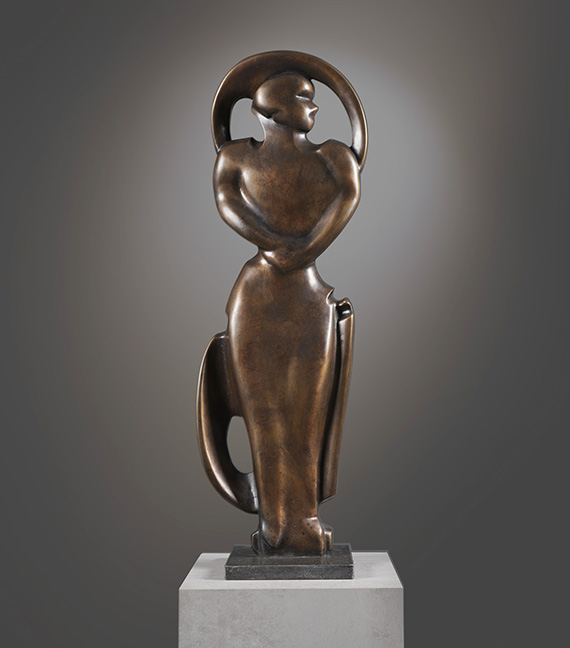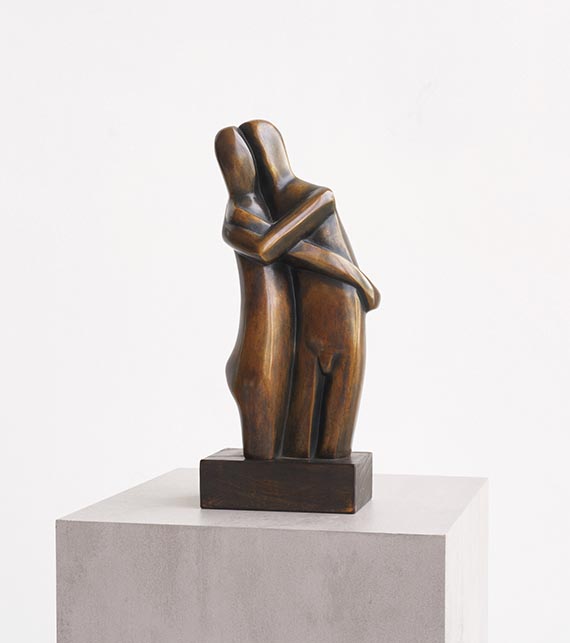Video
Verso
Autre image
Autre image
Autre image
153
Margarete Moll
Aurora (Morgenröte), 1949.
Bronze with brownish patina
Prix d´après-vente: € 14,000 / $ 16,520
Aurora (Morgenröte). 1949.
Bronze with brownish patina.
Signature and foundry mark “BRONZE ART STRANSKY” at the bottom on the reverse. From an edition of four posthumous casts. 75 x 24 x 6 cm (29.5 x 9.4 x 2.3 in).
Posthumous cast based on a wooden sculpture (1949). No cast of “Aurora” was made during the artist's lifetime.
• Based on a wooden sculpture Margarete Moll made during her time in England (1947–1951), where she came into contact with artists such as Reg Butler and Henry Moore.
• She was represented in important exhibitions alongside Käthe Kollwitz, Milly Steger, and Renée Sintenis at the beginning of the 20th century.
• Margarete Moll was Henri Matisse's only German student in Paris.
• She began her sculptural work even before Käthe Kollwitz, Emy Roeder, and Renée Sintenis.
• The bronze was part of the extensive exhibition of the artist's work, “Gemischtes Doppel. Die Molls und die Purrmanns – Zwei Künstlerpaare der Moderne” at the Museum Wiesbaden (October 13, 2023–February 18, 2024).
PROVENANCE: From the artist's estate.
Private collection, North Rhine-Westphalia.
EXHIBITION: Gemischtes Doppel. Die Molls und die Purrmanns, Museum Wiesbaden August 12, 2023–February 18, 2024; Edwin Scharff Museum, Neu-Ulm, April 27–August 18, 2024.
LITERATURE: Werner Filmer, Marg Moll. Eine deutsche Bildhauerin 1884-1977, no p. 2024, illustrated on p. 169 (different copy).
-
Roman Zieglgänsberger (ed.), Gemischtes Doppel. Die Molls und die Purrmanns, Petersberg/Wiesbaden 2023, illustrated on p. 212.
Bronze with brownish patina.
Signature and foundry mark “BRONZE ART STRANSKY” at the bottom on the reverse. From an edition of four posthumous casts. 75 x 24 x 6 cm (29.5 x 9.4 x 2.3 in).
Posthumous cast based on a wooden sculpture (1949). No cast of “Aurora” was made during the artist's lifetime.
• Based on a wooden sculpture Margarete Moll made during her time in England (1947–1951), where she came into contact with artists such as Reg Butler and Henry Moore.
• She was represented in important exhibitions alongside Käthe Kollwitz, Milly Steger, and Renée Sintenis at the beginning of the 20th century.
• Margarete Moll was Henri Matisse's only German student in Paris.
• She began her sculptural work even before Käthe Kollwitz, Emy Roeder, and Renée Sintenis.
• The bronze was part of the extensive exhibition of the artist's work, “Gemischtes Doppel. Die Molls und die Purrmanns – Zwei Künstlerpaare der Moderne” at the Museum Wiesbaden (October 13, 2023–February 18, 2024).
PROVENANCE: From the artist's estate.
Private collection, North Rhine-Westphalia.
EXHIBITION: Gemischtes Doppel. Die Molls und die Purrmanns, Museum Wiesbaden August 12, 2023–February 18, 2024; Edwin Scharff Museum, Neu-Ulm, April 27–August 18, 2024.
LITERATURE: Werner Filmer, Marg Moll. Eine deutsche Bildhauerin 1884-1977, no p. 2024, illustrated on p. 169 (different copy).
-
Roman Zieglgänsberger (ed.), Gemischtes Doppel. Die Molls und die Purrmanns, Petersberg/Wiesbaden 2023, illustrated on p. 212.
153
Margarete Moll
Aurora (Morgenröte), 1949.
Bronze with brownish patina
Prix d´après-vente: € 14,000 / $ 16,520
Commission, taxes et droit de suite
Cet objet est offert avec imposition régulière ou avec imposition différentielle.
Calcul en cas d'imposition différentielle:
Prix d’adjudication jusqu’à 800 000 euros : frais de vente 32 %.
Des frais de vente de 27% sont facturés sur la partie du prix d’adjudication dépassant 800 000 euros. Ils sont additionnés aux frais de vente dus pour la partie du prix d’adjudication allant jusqu’à 800 000 euros.
Des frais de vente de 22% sont facturés sur la partie du prix d’adjudication dépassant 4 000 000 euros. Ils sont additionnés aux frais de vente dus pour la partie du prix d’adjudication allant jusqu’à 4 000 000 euros.
La commission comprend la TVA, mais celle-ci n'est pas indiquée.
Calcul en cas d'imposition régulière:
Prix d'adjudication jusqu'à 800 000 € : 27 % de commission.
Prix d'adjudication supérieur à 800 000 € : montants partiels jusqu'à 800 000 € 27 % de commission, montants partiels supérieurs à 800 000 € : 21 % de commission.
Prix d'adjudication supérieur à 4.000 000 € : montants partiels supérieurs à 4.000 000 € : 15 % de commission.
La TVA légale de 7 % est prélevée sur la somme du prix d'adjudication et de la commission.
Si vous souhaitez appliquer l'imposition régulière, merci de bien vouloir le communiquer par écrit avant la facturation.
Calcul en cas de droit de suite:
Pour les œuvres originales d’arts plastiques et de photographie d’artistes vivants ou d’artistes décédés il y a moins de 70 ans, soumises au droit de suite, une rémunération au titre du droit de suite à hauteur des pourcentages indiqués au § 26, al. 2 de la loi allemande sur les droits d’auteur (UrhG) est facturée en sus pour compenser la rémunération liée au droit de suite due par le commissaire-priseur conformément au § 26 UrhG. À ce jour, elle est calculée comme suit :
4 pour cent pour la part du produit de la vente à partir de 400,00 euros et jusqu’à 50 000 euros,
3 pour cent supplémentaires pour la part du produit de la vente entre 50 000,01 et 200 000 euros,
1 pour cent supplémentaire pour la part entre 200 000,01 et 350 000 euros,
0,5 pour cent supplémentaire pour la part entre 350 000,01 et 500 000 euros et
0,25 pour cent supplémentaire pour la part au-delà de 500 000 euros.
Le total de la rémunération au titre du droit de suite pour une revente s’élève au maximum à 12 500 euros.
Calcul en cas d'imposition différentielle:
Prix d’adjudication jusqu’à 800 000 euros : frais de vente 32 %.
Des frais de vente de 27% sont facturés sur la partie du prix d’adjudication dépassant 800 000 euros. Ils sont additionnés aux frais de vente dus pour la partie du prix d’adjudication allant jusqu’à 800 000 euros.
Des frais de vente de 22% sont facturés sur la partie du prix d’adjudication dépassant 4 000 000 euros. Ils sont additionnés aux frais de vente dus pour la partie du prix d’adjudication allant jusqu’à 4 000 000 euros.
La commission comprend la TVA, mais celle-ci n'est pas indiquée.
Calcul en cas d'imposition régulière:
Prix d'adjudication jusqu'à 800 000 € : 27 % de commission.
Prix d'adjudication supérieur à 800 000 € : montants partiels jusqu'à 800 000 € 27 % de commission, montants partiels supérieurs à 800 000 € : 21 % de commission.
Prix d'adjudication supérieur à 4.000 000 € : montants partiels supérieurs à 4.000 000 € : 15 % de commission.
La TVA légale de 7 % est prélevée sur la somme du prix d'adjudication et de la commission.
Si vous souhaitez appliquer l'imposition régulière, merci de bien vouloir le communiquer par écrit avant la facturation.
Calcul en cas de droit de suite:
Pour les œuvres originales d’arts plastiques et de photographie d’artistes vivants ou d’artistes décédés il y a moins de 70 ans, soumises au droit de suite, une rémunération au titre du droit de suite à hauteur des pourcentages indiqués au § 26, al. 2 de la loi allemande sur les droits d’auteur (UrhG) est facturée en sus pour compenser la rémunération liée au droit de suite due par le commissaire-priseur conformément au § 26 UrhG. À ce jour, elle est calculée comme suit :
4 pour cent pour la part du produit de la vente à partir de 400,00 euros et jusqu’à 50 000 euros,
3 pour cent supplémentaires pour la part du produit de la vente entre 50 000,01 et 200 000 euros,
1 pour cent supplémentaire pour la part entre 200 000,01 et 350 000 euros,
0,5 pour cent supplémentaire pour la part entre 350 000,01 et 500 000 euros et
0,25 pour cent supplémentaire pour la part au-delà de 500 000 euros.
Le total de la rémunération au titre du droit de suite pour une revente s’élève au maximum à 12 500 euros.




 Lot 153
Lot 153 

